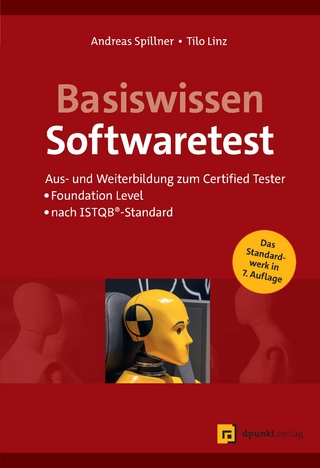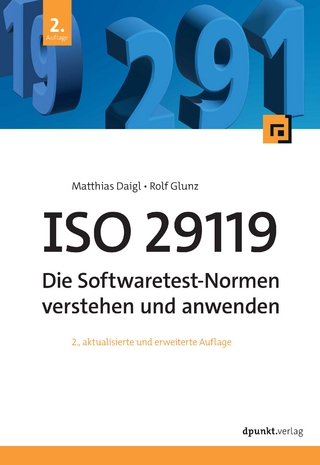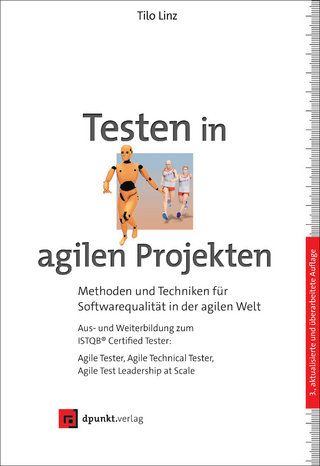
Software Quality Assurance
John Wiley & Sons Inc (Verlag)
978-1-118-50182-5 (ISBN)
Includes supplementary website with an instructor’s guide and solutions
Applies IEEE software standards as well as the Capability Maturity Model Integration for Development (CMMI)
Illustrates the application of software quality assurance practices through the use of practical examples, quotes from experts, and tips from the authors
Claude Y. Laporte, PhD, has coordinated the development, implementation, and deployment of systems and software engineering processes and project management processes, and has trained software engineers in America, Europe, and Asia. Since 2000, he has been a professor at the École de technologie supérieure (ÉTS), a Canadian engineering school, where he teaches software engineering. In 2013, Professor Laporte was awarded an honorary doctorate for his contributions to software engineering. He is the Project Editor of the set of ISO/IEC 29110 systems and software engineering life cycle standards and guides developed specifically for Very Small Entities (VSEs). He has also written two French software engineering textbooks with Dr. April. Dr. Laporte is a co-author of another book targeted at managers of small systems engineering organizations. Alain April, PhD, is a full professor of software engineering and IT at ÉTS University, Québec, Canada. He specializes in software quality assurance and IT process mapping/conformity in the industry transfer of Big Data HPC applications based on Spark, H2O.ai, and other cloud computing technologies applied to healthcare, construction, banking, and financial industries. Professor April has been developing healthcare HPC applications in the area of genomic visualization, genotyping sequencing, and whole genome sequencing, extending Berkeley's Adam data structure for HPC. These applied research projects deploy large-scale machine learning algorithms in research hospitals for specific use cases, such as type 2 diabetes early prediction and leukemia treatments in children.
Preface xv
Acknowledgments xxiii
1. Software Quality Fundamentals 1
1.1 Introduction 1
1.2 Defining Software Quality 2
1.3 Software Errors, Defects, and Failures 4
1.3.1 Problems with Defining Requirements 10
1.3.2 Maintaining Effective Communications Between Client and Developer 13
1.3.3 Deviations from Specifications 14
1.3.4 Architecture and Design Errors 15
1.3.5 Coding Errors 15
1.3.6 Non-Compliance with Current Processes/Procedures 16
1.3.7 Inadequate Reviews and Tests 17
1.3.8 Documentation Errors 17
1.4 Software Quality 19
1.5 Software Quality Assurance 20
1.6 Business Models and the Choice of Software Engineering Practices 22
1.6.1 Description of the Context 23
1.6.2 Anxiety and Fear 24
1.6.3 Choice of Software Practices 25
1.6.4 Business Model Descriptions 25
1.6.5 Description of Generic Situational Factors 26
1.6.6 Detailed Description of Each Business Model 27
1.7 Success Factors 32
1.8 Further Reading 33
1.9 Exercises 34
2. Quality Culture 35
2.1 Introduction 35
2.2 Cost of Quality 39
2.3 Quality Culture 49
2.4 The Five Dimensions of a Software Project 53
2.5 The Software Engineering Code of Ethics 56
2.5.1 Abridged Version: Preamble 58
2.5.2 The Example of the Code of Ethics of the Ordre des ingénieurs du Québec 60
2.5.3 Whistle Blowers 61
2.6 Success Factors 62
2.7 Further Reading 63
2.8 Exercises 63
3. Software Quality Requirements 66
3.1 Introduction 66
3.2 Software Quality Models 69
3.2.1 Initial Model Proposed by McCall 71
3.2.2 The First Standardized Model: IEEE 1061 73
3.2.3 Current Standardized Model: ISO 25000 Set of Standards 77
3.3 Definition of Software Quality Requirements 86
3.3.1 Specifying Quality Requirements: The Process 91
3.4 Requirement Traceability During the Software Life Cycle 95
3.5 Software Quality Requirements and the Software Quality Plan 95
3.6 Success Factors 96
3.7 Further Reading 97
3.8 Exercises 97
4. Software Engineering Standards and Models 101
4.1 Introduction 101
4.2 Standards, Cost of Quality, and Business Models 108
4.3 Main Standards for Quality Management 109
4.3.1 ISO 9000 Family 109
4.3.2 ISO/IEC 90003 Standard 115
4.4 ISO/IEC/IEEE 12207 Standard 117
4.4.1 Limitations of the ISO 12207 Standard 121
4.5 ISO/IEC/IEEE 15289 Standard for the Description of Information Elements 121
4.6 IEEE 730 Standard for SQA Processes 123
4.6.1 Activities and Tasks of SQA 125
4.7 Other Quality Models, Standards, References, and Processes 129
4.7.1 Process Maturity Models of the SEI 130
4.7.2 Software Maintenance Maturity Model (S 3m) 135
4.7.3 ITIL Framework and ISO/IEC 20000 138
4.7.4 CobiT Process 142
4.7.5 ISO/IEC 27000 Family of Standards for Information Security 143
4.7.6 ISO/IEC 29110 Standards and Guides for Very Small Entities 144
4.7.7 ISO/IEC 29110 Standards for VSEs Developing Systems 155
4.8 Specific Standards for an Application Domain 156
4.8.1 DO-178 and ED-12 Guidance for Airborne Systems 156
4.8.2 EN 50128 Standard for Railway Applications 159
4.8.3 ISO 13485 Standard for Medical Devices 161
4.9 Standards and the SQAP 163
4.10 Success Factors 165
4.11 Further Reading 165
4.12 Exercises 166
5. Reviews 167
5.1 Introduction 167
5.2 Personal Review and Desk-Check Review 172
5.2.1 Personal Review 172
5.2.2 Desk-Check Reviews 175
5.3 Standards and Models 179
5.3.1 ISO/IEC 20246 Software and Systems Engineering: Work Product Reviews 179
5.3.2 Capability Maturity Model Integration 180
5.3.3 The IEEE 1028 Standard 181
5.4 Walk-Through 184
5.4.1 Usefulness of a Walk-Through 184
5.4.2 Identification of Roles and Responsibilities 186
5.5 Inspection Review 187
5.6 Project Launch Reviews and Project Assessments 189
5.6.1 Project Launch Review 190
5.6.2 Project Retrospectives 192
5.7 Agile Meetings 197
5.8 Measures 199
5.9 Selecting the Type of Review 202
5.10 Reviews and Business Models 205
5.11 Software Quality Assurance Plan 205
5.12 Success Factors 206
5.13 Tools 208
5.14 Further Reading 208
5.15 Exercises 208
6. Software Audits 210
6.1 Introduction 210
6.2 Types of Audits 215
6.2.1 Internal Audit 215
6.2.2 Second-Party Audit 215
6.2.3 Third-Party Audit 217
6.3 Audit and Software Problem Resolution According to Iso/iec/ieee 12207 217
6.3.1 Project Assessment and Control Process 218
6.3.2 Decision Management Process 218
6.4 Audit According to the IEEE 1028 Standard 218
6.4.1 Roles and Responsibilities 220
6.4.2 IEEE 1028 Audit Clause 221
6.4.3 Audit Conducted According to IEEE 1028 222
6.5 Audit Process and the ISO 9001 Standard 225
6.5.1 Steps of a Software Audit 226
6.6 Audit According to the CMMI 230
6.6.1 SCAMPI Assessment Method 231
6.7 Corrective Actions 233
6.7.1 Corrective Actions Process 234
6.8 Audits for Very Small Entities 238
6.9 Audit and the SQA Plan 239
6.10 Presentation of an Audit Case Study 241
6.11 Success Factors 246
6.12 Further Reading 247
6.13 Exercises 247
7. Verification and Validation 249
7.1 Introduction 249
7.2 Benefits and Costs of V&V 255
7.2.1 V&V and the Business Models 257
7.3 V&V Standards and Process Models 257
7.3.1 IEEE 1012 V&V Standard 258
7.3.2 Integrity Levels 260
7.3.3 Recommended V&V Activities for Software Requirements 262
7.4 V&V According to ISO/IEC/IEEE 12207 263
7.4.1 Verification Process 265
7.4.2 Validation Process 265
7.5 V&V According to the CMMI Model 266
7.6 ISO/IEC 29110 and V&V 267
7.7 Independent V&V 268
7.7.1 IV&V Advantages with Regards to SQA 271
7.8 Traceability 271
7.8.1 Traceability Matrix 273
7.8.2 Implementing Traceability 276
7.9 Validation Phase of Software Development 277
7.9.1 Validation Plan 279
7.10 Tests 281
7.11 Checklists 282
7.11.1 How to Develop a Checklist 283
7.11.2 How to Use a Checklist 285
7.11.3 How to Improve and Manage a Checklist 286
7.12 V&V Techniques 287
7.12.1 Introduction to V&V Techniques 287
7.12.2 Some V&V Techniques 288
7.13 V&V Plan 289
7.14 Limitations of V&V 290
7.15 V&V in the SQA Plan 291
7.16 Success Factors 292
7.17 Further Reading 293
7.18 Exercises 293
8. Software Configuration Management 295
8.1 Introduction 295
8.2 Software Configuration Management 296
8.3 Benefits of Good Configuration Management 297
8.3.1 cm According to ISO 12207 298
8.3.2 cm According to IEEE 828 299
8.3.3 cm According to the cmMI 299
8.4 SCM Activities 301
8.4.1 Organizational Context of SCM 301
8.4.2 Developing a SCM Plan 302
8.4.3 Identification of CI to be Controlled 303
8.5 Baselines 309
8.6 Software Repository and Its Branches 311
8.6.1 A Simple Branching Strategy 315
8.6.2 A Typical Branching Strategy 316
8.7 Configuration Control 318
8.7.1 Requests, Evaluation, and Approval of Changes 319
8.7.2 Configuration Control Board 321
8.7.3 Request for Waivers 322
8.7.4 Change Management Policy 322
8.8 Configuration Status Accounting 323
8.8.1 Information Concerning the Status of ci 323
8.8.2 Configuration Item Status Reporting 325
8.9 Software Configuration Audit 325
8.9.1 Functional Configuration Audit 327
8.9.2 Physical Configuration Audit 327
8.9.3 Audits Performed During a Project 328
8.10 Implementing SCM in Very Small Entities with Iso/iec 29110 329
8.11 SCM and the SQAP 330
8.12 Success Factors 331
8.13 Further Reading 333
8.14 Exercises 333
9. Policies, Processes, and Procedures 335
9.1 Introduction 335
9.1.1 Standards, the Cost of Quality, and Business Models 341
9.2 Policies 341
9.3 Processes 345
9.4 Procedures 351
9.5 Organizational Standards 352
9.6 Graphical Representation of Processes and Procedures 353
9.6.1 Some Pitfalls to Avoid 356
9.6.2 Process Mapping 357
9.6.3 ETVX Process Notation 357
9.6.4 IDEF Notation 366
9.6.5 BPMN Notation 370
9.7 Process Notation of ISO/IEC 29110 376
9.8 Case Study 383
9.9 Personal Improvement Process 388
9.10 Policies, Processes, and Procedures in the SQA Plan 393
9.11 Success Factors 394
9.12 Further Reading 395
9.13 Exercises 396
10. Measurement 397
10.1 Introduction—the Importance of Measurement 397
10.1.1 Standards, the Cost of Quality, and Software Business Models 401
10.2 Software Measurement According to Iso/iec/ieee 12207 402
10.3 Measurement According to ISO 9001 403
10.4 The Practical Software and Systems Measurement Method 404
10.5 ISO/IEC/IEEE 15939 Standard 411
10.5.1 Measurement Process According to ISO 15939 412
10.5.2 Activities and Tasks of the Measurement Process 412
10.5.3 An Information Measurement Model of ISO 15939 412
10.6 Measurement According to the CMMI Model 418
10.7 Measurement in Very Small Entities 421
10.8 The Survey as a Measurement Tool 421
10.9 Implementing a Measurement Program 425
10.9.1 Step 1: Management Commitment Build-Up 426
10.9.2 Step 2: Staff Commitment Build-Up 427
10.9.3 Step 3: Selection of Key Processes to be Improved 427
10.9.4 Step 4: Identification of the Goals and Objectives Related to the Key Process 427
10.9.5 Step 5: Design of the Measurement Program 427
10.9.6 Step 6: Description of the Information System to Support Measurement 428
10.9.7 Step 7: Deployment of the Measurement Program 428
10.10 Practical Considerations 430
10.10.1 Some Pitfalls with Regards to Measurement 432
10.11 The Human Side of Measurement 435
10.11.1 Cost of Measurement 438
10.12 Measurement and the IEEE 730 SQAP 439
10.12.1 Software Process Measurement 440
10.12.2 Software Product Measurement 441
10.13 Success Factors 443
10.14 Further Reading 443
10.15 Exercises 444
11. Risk Management 445
11.1 Introduction 445
11.1.1 Risk, the Cost of Quality and Business Models 451
11.1.2 Costs and Benefits of Risk Management 453
11.2 Risk Management According to Standards and Models 454
11.2.1 Risk Management According to ISO 9001 454
11.2.2 Risk Management According to ISO/IEC/IEEE 12207 455
11.2.3 Risk Management According to ISO/IEC/IEEE 16085 456
11.2.4 Risk Management According to the CMMI Model 459
11.2.5 Risk Management According to PMBOK ® Guide 461
11.2.6 Risk Management According to ISO 29110 462
11.2.7 Risk Management and the SQA According to IEEE 730 465
11.3 Practical Considerations for Risk Management 466
11.3.1 Risk Evaluation Step 468
11.3.2 Risk Control Step 474
11.3.3 Lessons Learned Activity 477
11.4 Risk Management Roles 478
11.5 Measurement and Risk Management 479
11.6 Human Factors and Risk Management 483
11.7 Success Factors 485
11.8 Conclusion 486
11.9 Further Reading 487
11.10 Exercises 487
12. Supplier Management and Agreements 489
12.1 Introduction 489
12.2 Supplier Requirements of ISO 9001 490
12.3 Agreement Processes of ISO 12207 491
12.4 Supplier Agreement Management According to the CMMI 494
12.5 Managing Suppliers 496
12.6 Software Acquisition Life Cycle 497
12.7 Software Contract Types 499
12.7.1 Fixed Price Contract 501
12.7.2 Cost plus Percentage of Cost 502
12.7.3 Cost plus Fixed Fee 502
12.7.4 Risk Sharing 502
12.8 Software Contract Reviews 505
12.8.1 Two Reviews: Initial and Final 505
12.8.2 Initial Contract Review 506
12.8.3 Final Contract Review 509
12.9 Supplier and Acquirer Relationship and the SQAP 510
12.10 Success Factors 511
12.11 Further Reading 512
12.12 Exercises 512
13. Software Quality Assurance Plan 514
13.1 Introduction 514
13.2 SQA Planning 518
13.2.1 Purpose and Scope 518
13.2.2 Definitions and Acronyms 518
13.2.3 Reference Documents 519
13.2.4 SQAP Overview—Organization and Independence 520
13.2.5 SQAP Overview—Software Product Risk 524
13.2.6 SQAP Overview—Tools 525
13.2.7 SQAP Overview—Standards, Practices, and Conventions 525
13.2.8 SQAP Overview—Effort, Resources, and Schedule 526
13.2.9 Activities, Outcomes, and Tasks—Product Assurance 528
13.2.10 Activities, Outcomes, and Tasks—Process Assurance 529
13.2.11 Additional Considerations 531
13.2.12 SQA Records 536
13.3 Executing the SQAP 537
13.4 Conclusion 539
13.5 Further Reading 539
13.6 Exercises 540
Appendix 1. Software Engineering Code of Ethics and Professional Practice (Version 5.2) 541
Appendix 2. Incidents and Horror Stories Involving Software 549
Glossary – Abbreviations – Acronyms 555
References 576
Index 591
| Erscheint lt. Verlag | 9.2.2018 |
|---|---|
| Verlagsort | New York |
| Sprache | englisch |
| Maße | 155 x 231 mm |
| Gewicht | 1134 g |
| Themenwelt | Informatik ► Software Entwicklung ► Qualität / Testen |
| Mathematik / Informatik ► Mathematik ► Wahrscheinlichkeit / Kombinatorik | |
| Naturwissenschaften ► Biologie ► Biochemie | |
| Naturwissenschaften ► Chemie | |
| Technik ► Elektrotechnik / Energietechnik | |
| Technik ► Maschinenbau | |
| ISBN-10 | 1-118-50182-9 / 1118501829 |
| ISBN-13 | 978-1-118-50182-5 / 9781118501825 |
| Zustand | Neuware |
| Haben Sie eine Frage zum Produkt? |
aus dem Bereich


